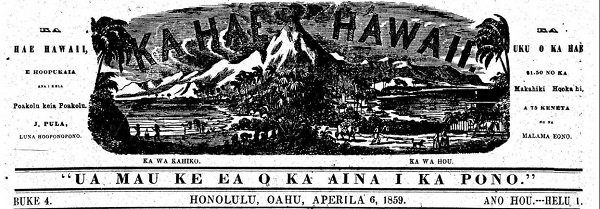
Ka ili ana o ke okohola 'South Seaman."
I ka la 7 o maraki iho nei holo aku nei ka moku okohola South Seaman, a i ka la 13 o ia malama, i ka hora 5 kakahiaka, ili aku la ia maluna o ke ahua o ka moku guano, e waiho ana i ka Latitu akau 23□ 40', a i ka Lon. 176□ 16' kom., he 600 paha na mile mai ia nei aku ma ke komohana. Kuhi iho la ke Kapena, ua hala ka moku mahope i ke ahiahi mamua. I kona ku ana i ke ahua, oki aku lakou i ke kia mua, a hina iho la. Hapai ae la na nalu i ka moku maluna o ke akoakoa, a pili paa iho la ia i kahi o ka papau he anana hookahi. Ua hukiia aku la na waapa elima me ke kaula maloko o ke kuanalu, a ku malaila ma ka heleuma. No ka nui loa o na nalu e poi mai ana maluna o ka moku, he ane hiki ole i kanaka ke haalele i ka moku. Ua malamaia na pahu wai elua, eha pahu berena, a me kekahi mau kikila io, me na waki, na palapala moana, a me na mea nana la. A hala na hora elua, e nahaha ana ka moku a piha koke i ke kai. Ua maheleia na kanaka me na mea ai iloko o na waapa, a haalele mai i ka moku, e manao ana e holo i Guama. Aole liuliu o ka holo ana, a hoea mai ka moku Kamehameha IV., e holo ana ilaila, e imi i ke Guano. Ee ae la lakou maluna o Kamehameha IV., a ua pae mai ke Kapena me na luina he 12. Koe aku malaila ka nui o lakou, e malama i ka ukana o ka moku ili, a e kii hou aku ana ke Kamehameha IV. ia lakou. Ua kukalaia ka moku nahaha maanei i na $955. Ua lilo i na ona o Kamehameha.
Ua holo aku nei o Mika Kalaka o Kawaiahao ma Nu Ioka a Bosetona, maluna o ka moku "Yankee" i Kapalakiko, malaila aku ma Panama a hiki i Nu Ioka. I ka la 28 o Maraki iho nei kona holo ana. E manao ana kela, a hala na malama ehiku, e hoi hou mai.
====================
Synopsis:
This article, from the newspaper Ka Hae Hawaii in 1859, talks about the whaling ship, the South Seaman, which became grounded atop a sandbar near a “guano island”. According to the article, this took place around 600 miles to the west of Hawai‘i. The crew barely escaped on several skiffs, saving what food, instruments, and maps they could, and headed for Guam, or so they thought. Soon after leaving on the skiffs, they were rescued by the ship, the Kamehameha IV, which happened to be in the waters looking for Guano Island.
This article is followed by a shorter unrelated one which states that a Hawaiian was sailing for many months from San Francisco to Panama to New York to Boston. [I have kept this shorter article here for the discussion below].
Context:
Following and overlapping with the era of international whaling, several nations of the world were obsessed with mining the guano-rich islands of the Pacific. In this article, these two capitalist ventures, depleting our Pacific resources for foreign monetary gain, intersect.
The bird guano was especially valued as an ingredient for fertilizer, gunpowder, and other things. According to a National Geographic article, “By 1850, guano cost as much as $76 per pound… about a quarter of the price of actual gold" (Vergano 2014). In 1856, the United States passed the Guano Islands Act which encouraged U.S. citizens to take control of uninhabited islands in the name of guano harvesting and which also legitimized American military intervention to protect such United States’ interests.
The grounding of the South Seaman whaling ship near one of these proclaimed Guano Islands took place soon after this enactment. Note also that up until this time, the United States did not claim to have Pacific possessions. At the time, the Mariana Islands were still united but under the Spanish flag, and the Hawaiian Islands were still an independent nation. By the end of the century, the U.S. would claim not only Guam and Hawai‘i, but the Philippine Islands as well.
Further Discussion:
According to historical records, the South Seaman went aground near the French Frigate Shoals (Than 2011), but the article gives coordinates that seem to be off by several degrees. Regardless, it appears that the location of the grounding was much closer to Honolulu than Haga’ña. Yet, the crew had every intention of sailing across the ocean to find safety on Guam rather than Hawai‘i, which was much closer, perhaps because they were going to follow the western equatorial current.
Note that in both of the articles above, some world-famous place names are mentioned as important sea ports/points. Guam is mentioned along with San Francisco, Panama, New York, and Boston. Our Pacific seafaring ancestors were familiar with traversing the vast ocean since ever since, before western contact. The routes to the Mariana Islands and the Hawaiian Islands were embedded in the knowledge of traditional navigators. But the possibility of such long-distance voyaging for sovereign Chamorus was crushed during the Spanish era, only to resurface later for Chamorus as “crew help” for the colonizers. What amount of traditional Chamoru oceanic knowledge had been lost due to the Spanish intrusion?
Another interesting thing with these articles is the literal and figurative place of the United States at this point in history. Indeed, the United States had not yet materialized as a country from the Atlantic to the Pacific. But American expansionists had already been using the questionable concept of Manifest Destiny to dominate Native American peoples and territories. And even further than that, the U.S. appetite was already looking to consume of the fruits of the Pacific like good ol’ American pie. Less than a century later, the sovereignty of Indigenous Islanders over their lands, skies, and waters would suffer the same fate as that of the Native Americans. Enter into this backdrop the Jones Act.
Back to the topic of guano mining. How often did these guano ships come to the Marianas? If Chamorus were recruited on whaling ships, it seems that they’d be recruited to work on ships in the guano business too. Were any of the Mariana Islands scouted for their guano potential, whether by Spain or another country? Our history shows us that there has been a pattern of diminishing our Pacific resources for the financial gain of foreign governments. What is the guano-mining venture or whaling venture of today, going on in our 21st century? Are there lessons from our guano-mining and whaling past that we should apply to certain current situations?
Bibiography
Than, Ker. “Rare 1823 Wreck Found --- Capt. Linked to ‘Moby Dick,’ Cannibalism.” National Geographic. 11 Feb. 2011. https://news.nationalgeographic.com/news/2011/02/110211-two-brothers-whaling- ship-pollard-science-nantucket-noaa. Accessed 5 Feb. 2018.
Vergano, Dan. “Bird Droppings Led to U.S. Possession of Newly Protected Pacific Islands.” National Geographic. 18 Sep. 2014. https://news.nationalgeographic.com/news/2014/09/140926-pacific-island-guano-national-monument-history. Accessed 5 Feb. 2018.
A si Yu’us ma’ase once again to my colleagues Keoni Ezell and Kaleo Kaho‘onei for sharing their thoughts on my translation of the articles.

